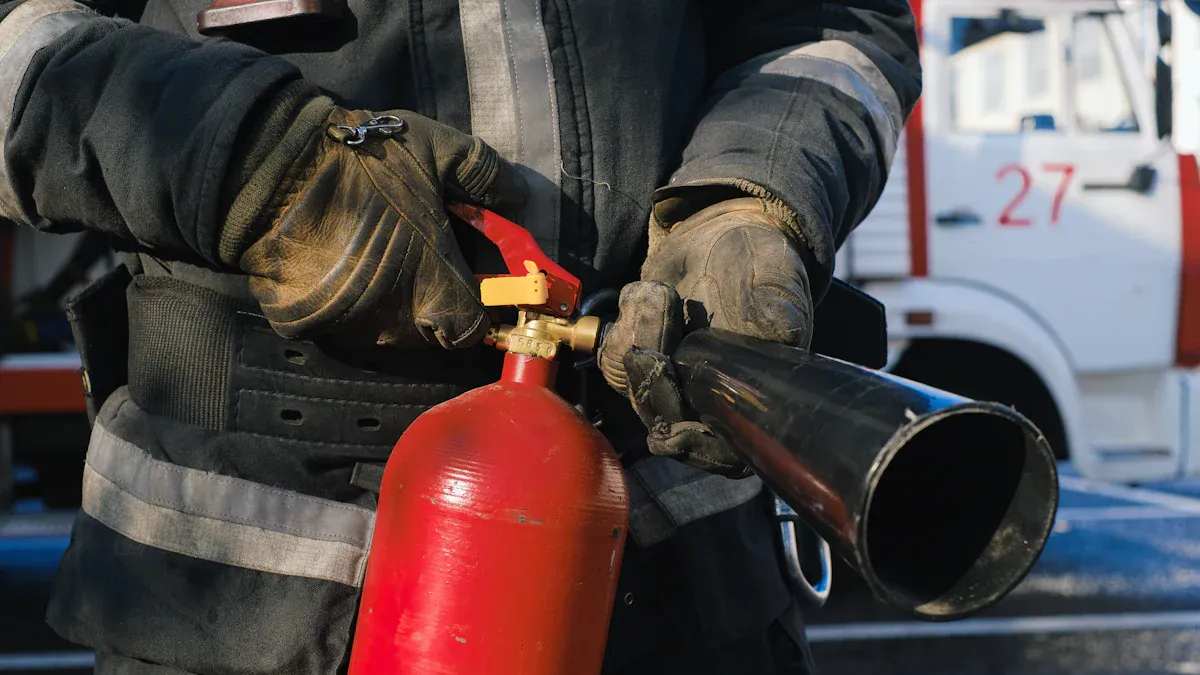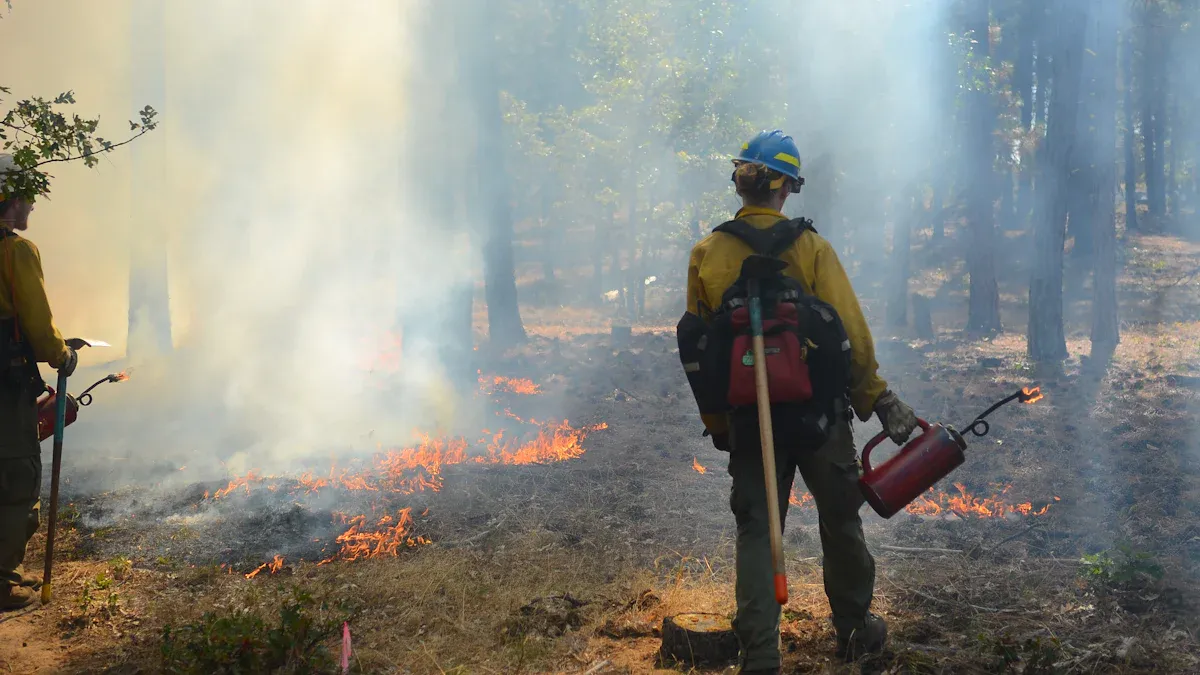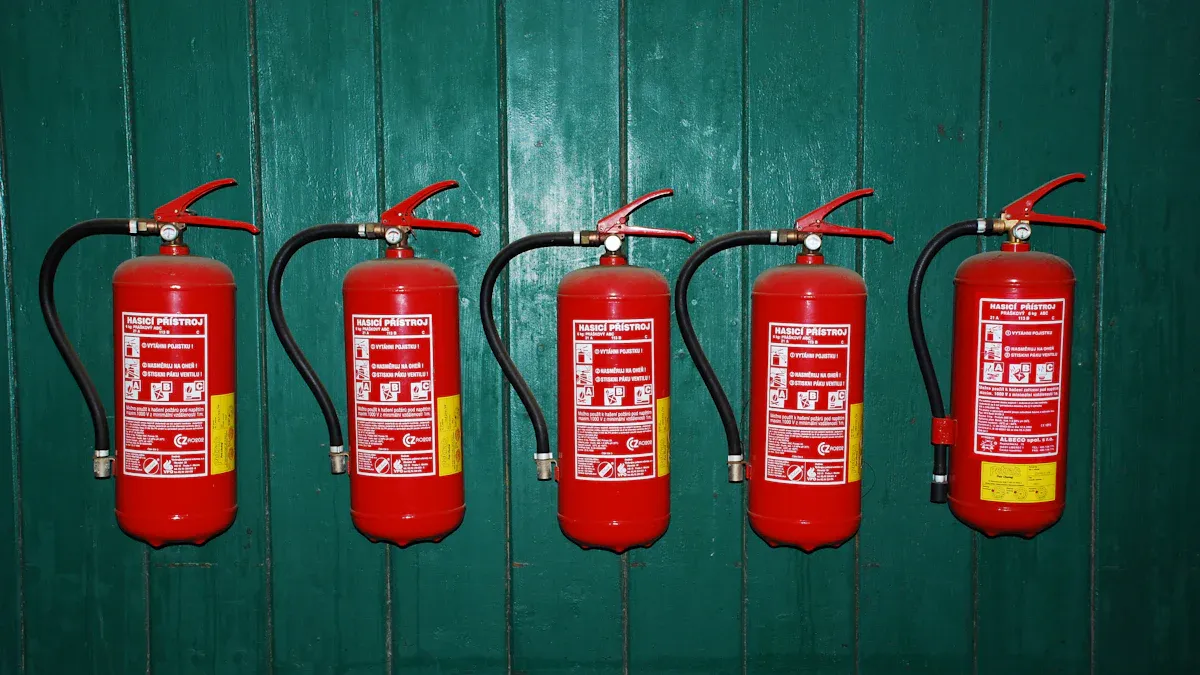
Fire extinguishers provide an essential line of defense against fire emergencies. Their portable design allows individuals to combat flames effectively before they escalate. Tools like the dry powder fire extinguisher and the CO2 fire extinguisher have significantly improved fire safety. These innovations continue to play a vital role in minimizing fire-related injuries and property damage.
Key Takeaways
- Fire extinguishers are important tools to stop small fires fast.
- There are different fire extinguishers for different kinds of fires.
- Checking them often and learning to use them helps in emergencies.
The History of Fire Extinguishers

Early Firefighting Tools
Before the invention of the fire extinguisher, early civilizations relied on rudimentary tools to combat fires. Buckets of water, wet blankets, and sand were the primary methods used to extinguish flames. In ancient Rome, organized firefighting brigades, known as “Vigiles,” utilized hand pumps and water buckets to control fires in urban areas. These tools, while effective to some extent, lacked the precision and efficiency needed to tackle fires quickly.
The Industrial Revolution brought advancements in firefighting technology. Devices like hand-operated fire pumps and syringes emerged, allowing firefighters to direct water streams more accurately. However, these tools were bulky and required multiple individuals to operate, limiting their practicality for personal or small-scale use.
The First Fire Extinguisher by Ambrose Godfrey
In 1723, Ambrose Godfrey, a German chemist, revolutionized fire safety by patenting the first fire extinguisher. His invention consisted of a cask filled with fire-extinguishing liquid and a chamber containing gunpowder. When activated, the gunpowder exploded, dispersing the liquid over the flames. This innovative design provided a more targeted and effective approach to extinguishing fires compared to earlier methods.
Historical records highlight the effectiveness of Godfrey’s invention during a fire at the Crown Tavern in London in 1729. The device successfully controlled the blaze, showcasing its potential as a lifesaving tool. Godfrey’s fire extinguisher marked the beginning of a new era in fire safety, inspiring future innovations in firefighting technology.
Evolution to Modern Portable Fire Extinguishers
The journey from Godfrey’s invention to the modern fire extinguisher involved numerous milestones. In 1818, George William Manby introduced a portable copper vessel containing a potassium carbonate solution under compressed air. This design allowed users to spray the solution directly onto flames, making it more practical for individual use.
Subsequent innovations further refined fire extinguishers. In 1881, Almon M. Granger patented the soda-acid extinguisher, which used a chemical reaction between sodium bicarbonate and sulfuric acid to create pressurized water. By 1905, Alexander Laurant developed a chemical foam extinguisher, which proved effective against oil fires. The Pyrene Manufacturing Company introduced carbon tetrachloride extinguishers in 1910, offering a solution for electrical fires.
The 20th century saw the emergence of modern extinguishers using CO2 and dry chemicals. These devices became more compact, efficient, and versatile, catering to different fire classes. Today, fire extinguishers are indispensable tools in homes, offices, and industrial settings, ensuring safety and minimizing fire-related risks.
| Year | Inventor/Creator | Description |
|---|---|---|
| 1723 | Ambrose Godfrey | First recorded fire extinguisher, using gunpowder to disperse liquid. |
| 1818 | George William Manby | Copper vessel with potassium carbonate solution under compressed air. |
| 1881 | Almon M. Granger | Soda-acid extinguisher using sodium bicarbonate and sulfuric acid. |
| 1905 | Alexander Laurant | Chemical foam extinguisher for oil fires. |
| 1910 | Pyrene Manufacturing Company | Carbon tetrachloride extinguisher for electrical fires. |
| 1900s | Various | Modern extinguishers with CO2 and dry chemicals for diverse applications. |
The evolution of fire extinguishers reflects humanity’s commitment to improving fire safety. Each innovation has contributed to making fire extinguishers more accessible, effective, and reliable.
Technological Advancements in Fire Extinguishers

Development of Extinguishing Agents
The evolution of extinguishing agents has significantly enhanced the effectiveness of fire extinguishers. Early designs relied on basic solutions like potassium carbonate or water, which were limited in their ability to combat diverse fire types. Modern advancements introduced specialized agents tailored to specific fire classes, improving safety and efficiency.
For instance, dry chemical agents, such as monoammonium phosphate, became widely used due to their versatility in extinguishing Class A, B, and C fires. These agents interrupt the chemical reactions fueling the fire, making them highly effective. Carbon dioxide (CO2) emerged as another critical development. Its ability to displace oxygen and cool flames made it ideal for electrical fires and flammable liquids. Additionally, wet chemical agents were developed to address Class K fires, commonly found in commercial kitchens. These agents form a soapy layer over burning oils and fats, preventing re-ignition.
Clean agent extinguishers, which use gases like FM200 and Halotron, represent a leap forward in fire safety. These agents are non-conductive and leave no residue, making them suitable for environments with sensitive equipment, such as data centers and museums. The continuous refinement of extinguishing agents ensures that fire extinguishers remain effective across various scenarios.
Innovations in Fire Extinguisher Design
Advancements in design have transformed fire extinguishers into more user-friendly and efficient tools. Early models were bulky and challenging to operate, limiting their accessibility. Modern designs prioritize portability, ease of use, and durability, ensuring that individuals can respond quickly during emergencies.
One notable innovation is the introduction of pressure gauges, which allow users to verify the readiness of an extinguisher at a glance. This feature reduces the risk of deploying a non-functional device during a critical moment. Additionally, ergonomic handles and lightweight materials have improved the usability of fire extinguishers, enabling individuals of varying physical abilities to operate them effectively.
Another significant development is the incorporation of color-coded labels and clear instructions. These enhancements simplify the identification of extinguisher types and their appropriate applications, reducing confusion during high-stress situations. Furthermore, advancements in nozzle technology have improved the precision and reach of extinguishing agents, ensuring that fires can be tackled more effectively.
Modern Fire Extinguisher Types and Applications
Modern fire extinguishers are categorized based on their suitability for specific fire classes, ensuring targeted and efficient fire suppression. Each type addresses unique fire hazards, making them indispensable in various settings.
- Class A Fire Extinguishers: Designed for common combustible materials like wood, paper, and textiles, these extinguishers are essential in residential and commercial environments.
- Class B Fire Extinguishers: Effective against flammable liquids such as gasoline and oil, these are crucial in industrial facilities and workshops.
- Class C Fire Extinguishers: Specifically engineered for electrical fires, these extinguishers use non-conductive agents to ensure safety.
- Class K Fire Extinguishers: Wet chemical extinguishers are tailored for commercial kitchens, where cooking oils and fats pose significant fire risks.
- Clean Agent Extinguishers: Ideal for protecting high-value assets, these extinguishers use gases like FM200 and Halotron to suppress fires without causing water damage.
The versatility of modern fire extinguishers ensures their effectiveness in diverse environments. Whether safeguarding homes, offices, or specialized facilities, these tools remain a cornerstone of fire safety.
The Impact of Fire Extinguishers on Fire Safety
Role in Building Codes and Regulations
Fire extinguishers play a critical role in ensuring compliance with building codes and fire safety regulations. Standards like NFPA 10 mandate the proper selection, placement, and maintenance of extinguishers in residential, commercial, and industrial buildings. These regulations aim to provide occupants with accessible tools to combat early-stage fires, preventing their escalation. By extinguishing small fires quickly, fire extinguishers reduce the need for more extensive firefighting measures, such as fire hoses or external fire services. This swift response minimizes property damage and enhances occupant safety.
| Evidence Type | Description |
|---|---|
| Role of Fire Extinguishers | Fire extinguishers provide occupants with a means to combat early-stage fires, reducing their spread. |
| Speed of Response | They can extinguish small fires more quickly than building fire hoses or local fire services. |
| Compliance Requirements | Proper selection and placement are mandated by codes like NFPA 10, ensuring effectiveness. |
Contribution to Fire Prevention and Awareness
Fire extinguishers contribute significantly to fire prevention by fostering awareness of fire hazards. Their presence in buildings serves as a constant reminder of the importance of fire safety. Regular inspections and maintenance, often required by law, encourage individuals to remain vigilant about potential fire risks. Additionally, fire extinguishers highlight the need for proactive measures, such as identifying and mitigating fire hazards in workplaces and homes. This awareness reduces the likelihood of fire incidents and promotes a culture of safety.
Importance in Fire Safety Training Programs
Fire safety training programs emphasize the proper use of fire extinguishers, equipping individuals with the skills needed to respond effectively during emergencies. These programs, often required under OSHA §1910.157, teach participants how to identify fire classes and select the appropriate extinguisher. Training outcomes demonstrate the importance of these tools in reducing fire-related injuries, deaths, and property damage. For instance, workplace fires result in over 5,000 injuries and 200 deaths annually, with direct property damage costs exceeding $3.74 billion in 2022. Proper training ensures that individuals can act swiftly and confidently, minimizing these devastating impacts.
| Outcome | Statistic |
|---|---|
| Injuries from workplace fires | Over 5,000 injuries annually |
| Deaths from workplace fires | Over 200 deaths annually |
| Property damage costs | $3.74 billion in direct property damage in 2022 |
| Compliance requirement | Required training under OSHA §1910.157 |
Fire extinguishers have revolutionized fire safety by providing an accessible and effective tool to combat fires. Their development showcases humanity’s ingenuity in addressing fire hazards. Future advancements will likely enhance their efficiency and adaptability, ensuring continued protection for lives and property in an ever-evolving world.
FAQ
1. How often should fire extinguishers be inspected?
Fire extinguishers should undergo monthly visual inspections and annual professional maintenance. This ensures they remain functional and comply with safety regulations.
Tip: Always check the pressure gauge to confirm the extinguisher is ready for use.
2. Can any fire extinguisher be used on all fire types?
No, fire extinguishers are designed for specific fire classes. Using the wrong type can worsen the situation. Always match the extinguisher to the fire class.
| Fire Class | Suitable Extinguisher Types |
|---|---|
| Class A | Water, Foam, Dry Chemical |
| Class B | CO2, Dry Chemical |
| Class C | CO2, Dry Chemical, Clean Agent |
| Class K | Wet Chemical |
3. What is the lifespan of a fire extinguisher?
Most fire extinguishers last 5 to 15 years, depending on the type and manufacturer. Regular maintenance extends their usability and ensures reliability during emergencies.
Note: Replace extinguishers showing signs of damage or low pressure immediately.
Post time: May-21-2025

